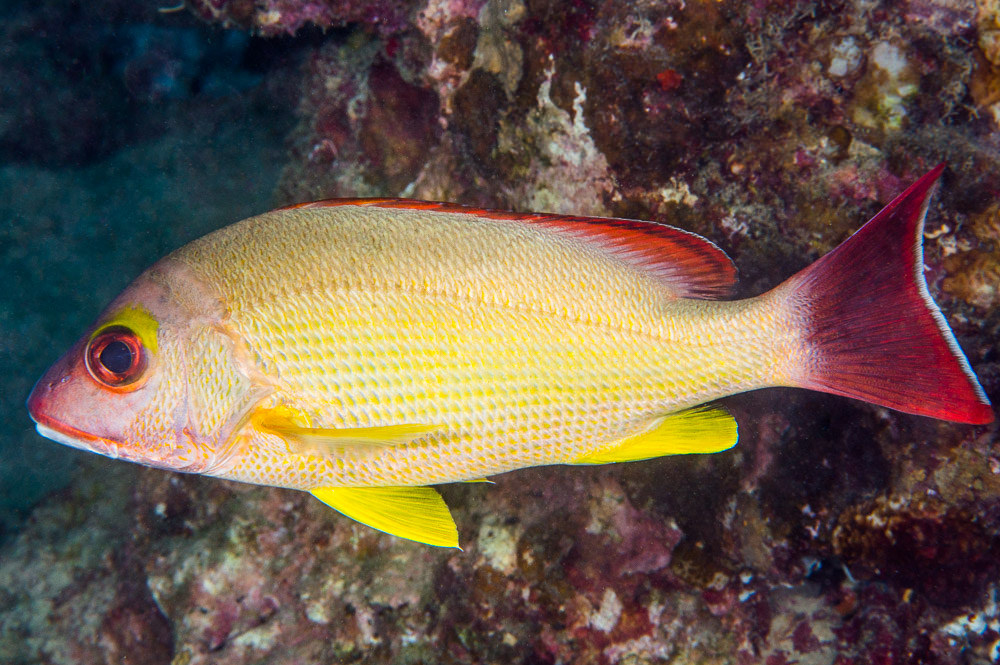Blacktail Snapper, Lutjanus fulvus (Bloch & Schneider 1801)
Other Names: Black-tail Snapper, Blacktailed Snapper, Flametail Snapper, Redmargined Seaperch, Waigeu Snapper, Yellowmargined Sea Perch, Yellow-margined Sea Perch, Yellow-margined Sea Perch, Yellow-margined Seaperch, Yellow-margined Sea-perch

A Blacktail Snapper, Lutjanus fulvus, in Tahiti, French Polynesia, November 2016. Source: zsispeo / Flickr. License: CC By Attribution-NonCommercial-ShareAlike
Summary:
An orange-brown or brownish to pale yellowish or whitish tropical snapper, with a white margin on dark reddish to blackish dorsal and caudal fins, yellow anal, pectoral and pelvic fins, brownish to yellow scale margins, and a yellow patch above the eye. Juveniles have yellowish stripes along the body and a black submarginal band on the dorsal fin.
Cite this page as:
Bray, D.J. 2018, Lutjanus fulvus in Fishes of Australia, accessed 10 Jul 2025, https://fishesofaustralia.net.au/home/species/556
Blacktail Snapper, Lutjanus fulvus (Bloch & Schneider 1801)
More Info
|
Distribution |
Known in the Australian region from Scott Reef, Western Australia, and Ashmore Reef, Timor Sea, to Sydney, New South Wales; also at Christmas Island and Cocos (Keeling) Islands in the eastern Indian Ocean, and Norfolk Island in the Tasman Sea. Elsewhere the species occurs in the tropical, Indo-west-central Pacific from the Red Sea and East Africa to the Tuamoto Islands in the Central pacific. The Blacktail Snapper was introduced to Hawaii from Moorea in 1956 to supplement stocks of edible reef fishes. Inhabits inshore coral reefs and lagoons, often sheltering in deep holes or areas with large boulders during the day - usually at depths of 2-40 m. Individuals may also enter mangrove areas and the lower parts of rivers and streams. |
|
Features |
Dorsal fin X, 13-14; Anal fin III, 8. Body depth 2.3-2.8 in SL; dorsal profile of head steeply sloped; preorbital bone about equal in width to eye diameter; preopercular notch and knob well developed. Scale rows on back rising obliquely above lateral line. |
|
Feeding |
Carnivore - usually feeds at night on fishes, crustaceans, cephalopod molluscs and holothurians (sea cucumbers). |
|
Species Citation |
Holocentrus fulvus Bloch & Schneider, 1801, Systema Ichthyologiae: 318. Type locality: Tahiti. |
|
Author |
Bray, D.J. 2018 |
|
Resources |
Blacktail Snapper, Lutjanus fulvus (Bloch & Schneider 1801)
References
Allen, G.R. 1985. FAO Species Catalogue. Snappers of the World. An annotated and illustrated catalogue of lutjanid species known to date. FAO Fisheries Synopsis No. 125, Vol. 6. Rome : FAO 208 pp.
Allen, G.R. 1997. Marine Fishes of Tropical Australia and South-east Asia. Perth : Western Australian Museum 292 pp. 106 pls.
Allen, G.R. & Erdmann, M.V. 2012. Reef fishes of the East Indies. Perth : Tropical Reef Research 3 vols, 1260 pp.
Allen, G.R. & Smith-Vaniz, W.F. 1994. Fishes of Cocos (Keeling) Islands. Atoll Research Bulletin 412: 1-21.
Allen, G.R. & Steene, R.C. 1988. Fishes of Christmas Island Indian Ocean. Christmas Island : Christmas Island Natural History Association 197 pp.
Allen, G.R., Steene, R.C. & Orchard, M. 2007. Fishes of Christmas Island.Christmas Island : Christmas Island Natural History Association 2 edn, 284 pp.
Allen, G.R. & Talbot, F.H. 1985. Review of the snappers of the genus Lutjanus (Pisces: Lutjanidae) from the Indo-Pacific, with the description of a new species. Indo-Pacific Fishes 11: 1-87.
Anderson, W.D. & Allen, G.R. 2001. Lutjanidae. pp. 2840-2918 in Carpenter, K.E. & Niem, V.H. (eds). The Living Marine Resources of the Western Central Pacific. FAO Species Identification Guide for Fisheries Purposes. Rome : FAO Vol. 5 2791-3379 pp.
Bartsch, A.F. & McFarren, E.F. 1962. Fish poisoning: a problem in food toxication. Pacific Science 16(1): 42-56.
Bloch, M.E. & Schneider, J.G. 1801. Systema Ichthyologiae Iconibus ex Illustratum. Berlin 584 pp. 110 pls.
De Vis, C.W. 1884. New Australian fishes in the Queensland Museum. Proceedings of the Linnean Society of New South Wales 1 9(2): 389-400 (as Genyoroge nigricauda)
Francis, M. 1993. Checklist of the coastal fishes of Lord Howe, Norfolk, and Kermadec Islands, southwest Pacific Ocean. Pacific Science 47(2): 136-170 figs 1-2
Gaither, M.R., Toonen, R.J., Robertson, D.R., Planes, S. & Bowden, B.W. 2010. Genetic evaluation of marine biogeographical barriers: perspectives from two widespread Indo-Pacific snappers (Lutjanus kasmira and Lutjanus fulvus). Journal of Biogeography 37: 133-147
Gloerfelt-Tarp, T. & Kailola, P.J. 1984. Trawled Fishes of Southern Indonesia and Northwest Australia. Jakarta : Dir. Gen. Fish. (Indonesia), German Tech. Coop., Aust. Dev. Ass. Bur. 406 pp.
Hutchins, J.B. 2001. Biodiversity of shallow reef fish assemblages in Western Australia using a rapid censusing technique. Records of the Western Australian Museum 20: 247-270.
Kuiter, R.H. 1992. Tropical Reef-Fishes of the Western Pacific, Indonesia and Adjacent Waters. Jakarta : PT Gramedia Pustaka Utama 314 pp. pls.
Marshall, T.C. 1964. Fishes of the Great Barrier Reef and Coastal Waters of Queensland. Sydney : Angus & Robertson 566 pp. 136 pls.
Randall, J.E. 2005. Reef and shore fishes of the South Pacific. New Caledonia to Tahiti and the Pitcairn Islands. Honolulu : University of Hawaii Press 707 pp.
Randall, J.E., Allen, G.R. & Steene, R. 1990. Fishes of the Great Barrier Reef and Coral Sea. Bathurst : Crawford House Press 507 pp. figs.
Randall, J.E., Allen, G.R. & Steene, R. 1997. Fishes of the Great Barrier Reef and Coral Sea. Bathurst : Crawford House Press 557 pp. figs.
Russell, B., Smith-Vaniz, W.F., Lawrence, A., Carpenter, K.E. & Myers, R. 2016. Lutjanus fulvus. The IUCN Red List of Threatened Species 2016: e.T194377A2325959. http://dx.doi.org/10.2305/IUCN.UK.2016-3.RLTS.T194377A2325959.en. Downloaded on 20 March 2018.
Shimose, T. & Nanami, A. 2014. Age, growth and reproductive biology of blacktail snapper, Lutjanus fulvus around the Yaeyama Islands, Okinawa, Japan. Ichthyological Research 61: 322-331.








